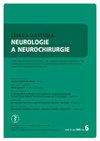Reaching the inferior fronto-occipital fascicle with the help of Klingler dissection and DTI tractography
IF 0.4
4区 医学
Q4 NEUROSCIENCES
引用次数: 0
Abstract
Aim: The aim of this study is to provide both image sources and a verbal description to allow the mental visualization of the course of the inferior fronto-occipital fascicle (IFOF) when looking at the brain from the lateral side, and to highlight the clinical importance of this associative white matter tract. Methods: In the three hemispheres of the brains of deceased donors, the IFOF was dissected using the Klingler method, with the aim to preserve as many intact cortical structures as possible. The spared cortical structures of the brain are good reference points for orientation on the brain surface. Diff usion tensor imaging (DTI) tractography was performed as another method to study the anatomical course of the IFOF. The data for the tractography were obtained using MRI examination in a healthy volunteer. Results: It was possible to dissect the IFOF in all three hemispheres. The course of the IFOF was documented in photographs of the dissections. Similarly, the course of the IFOF is depicted through the use of tractographic reconstructions and projections of these reconstructions in the MRI image of the brain. Both methods provide very similar results when it comes to IFOF anatomy. Conclusion: The availability of neuronavigation or other technological instruments did not reduce the need for knowledge of anatomy. The authors hope that the results presented in this project can serve to expand one’s knowledge or at least to awaken an interest in anatomy. Redakční rada potvrzuje, že rukopis práce splnil ICMJE kritéria pro publikace zasílané do biomedicínských časopisů. The Editorial Board declares that the manuscript met the ICMJE “uniform requirements” for在Klingler解剖和DTI束摄影的帮助下到达额枕下束
目的:本研究的目的是提供图像来源和语言描述,以便在从侧面观察大脑时对额枕下束(IFOF)的运动过程进行心理可视化,并强调这一相关白质束的临床重要性。方法:使用Klingler方法解剖死亡供者的三个大脑半球,目的是尽可能多地保留完整的皮层结构。脑皮层的备用结构是脑表面定位的良好参考点。采用弥散张量成像(DTI)示踪术研究IFOF的解剖过程。神经束造影的数据是通过对健康志愿者的核磁共振检查获得的。结果:可以解剖所有三个半球的IFOF。在解剖的照片中记录了IFOF的过程。同样,IFOF的过程是通过使用神经束重建和这些重建在大脑MRI图像中的投影来描述的。当涉及到IFOF解剖时,这两种方法提供非常相似的结果。结论:神经导航或其他技术工具的可用性并没有减少对解剖学知识的需求。作者希望在这个项目中提出的结果可以帮助扩大一个人的知识,或者至少唤醒对解剖学的兴趣。Redakční rada potvrzuje, že rukopis práce splnil ICMJE kritacriia pro publiclikace zasílané do biomedicínských asopisje。编辑委员会宣布该手稿符合ICMJE的“统一要求”
本文章由计算机程序翻译,如有差异,请以英文原文为准。
求助全文
约1分钟内获得全文
求助全文
来源期刊
CiteScore
0.70
自引率
60.00%
发文量
37
审稿时长
4-8 weeks
期刊介绍:
The Czech and Slovak Neurology and Neurosurgery is the official journal of five Czech and Slovak expert societies: the Czech Neurological Society, Slovak Neurological Society, Czech Neurosurgical Society, Slovak Neurosurgical Society and the Czech Society of Paediatric Neurology.
The journal is intended for all physicians interested in neuroscience, practical or theoretical.
The journal publishes original practice-based as well as basic research-focused neurological and neurosurgical papers, brief communications and case studies, all vigorously peer-reviewed, as well as review papers, commentaries, diagnostic and treatment standards and various thematic series (minimonographs with a knowledge test, statistical or web insights).

 求助内容:
求助内容: 应助结果提醒方式:
应助结果提醒方式:


